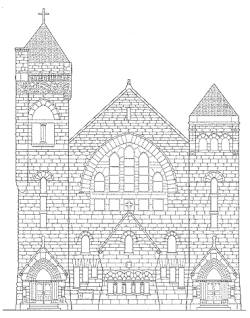Quinn Chapel AME Church (Chicago)
Quinn Chapel of the A.M.E. Church | |
 Quinn Chapel AME Church | |
| Location | 2401 S. Wabash Ave., Chicago, Illinois |
|---|---|
| Coordinates | 41°50′56″N 87°37′30″W / 41.84889°N 87.62500°W |
| Built | 1891 |
| Architect | Henry F. Starbuck |
| Architectural style | Romanesque Revival |
| NRHP reference No. | 79000827 |
| Significant dates | |
| Added to NRHP | September 4, 1979[2] |
| Designated CL | August 13, 1977[1] |
Quinn Chapel AME Church, also known as Quinn Chapel of the A.M.E. Church, houses Chicago's oldest African-American congregation, formed by seven individuals as a nondenominational prayer group that met in the house of a member in 1844. In 1847, the group organized as a congregation of the African Methodist Episcopal Church, the first independent black denomination in the United States. They named the church for Bishop William Paul Quinn.
In the years leading up to the Civil War, the church played an important role in the city's abolitionist movement. The 1871 Great Chicago Fire destroyed the original church. The congregation met for many years in temporary locations before purchasing the present site in 1890. The current structure, designed by architect Henry F. Starbuck and built in 1892 at 2401 South Wabash Avenue, reflects the area's late 19th-century character. The church was designated as a Chicago Landmark August 3, 1977, and was listed on the National Register of Historic Places September 4, 1979.[1] Considered architecturally significant, the church is featured in such books as Chicago Churches: A Photographic Essay by Elizabeth Johnson (Uppercase Books Inc, 1999) as well as Chicago Churches and Synagogues: An Architectural Pilgrimage, by George A. Lane (Loyola Press 1982).
In 1992, Quinn Chapel joined with three other nearby churches to found The Renaissance Collaborative: a non-profit organization devoted to saving the historic Wabash YMCA and fulfilling the needs of the Bronzeville community.[3]
References
- ^ a b "Quinn Chapel". Chicago Department of Planning and Development, Landmarks Division. 2003. Archived from the original on 2007-07-02. Retrieved 2007-06-29.
- ^ "National Register Information System". National Register of Historic Places. National Park Service. April 15, 2008.
- ^ "The Renaissance Collaborative". The Renaissance Collaborative. Retrieved 2013-10-29.
External links
 Media related to Quinn Chapel AME Church (Chicago) at Wikimedia Commons
Media related to Quinn Chapel AME Church (Chicago) at Wikimedia Commons- Official website
- Library of Congress Historic American Buildings
- 19th-century Methodist church buildings in the United States
- African Methodist Episcopal churches in Illinois
- Churches in Chicago
- Chicago Landmarks
- Properties of religious function on the National Register of Historic Places in Chicago
- Churches completed in 1892
- Churches on the National Register of Historic Places in Illinois
- Midwestern United States church stubs
- Illinois religious building and structure stubs
- Cook County, Illinois Registered Historic Place stubs
- Chicago building and structure stubs
